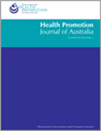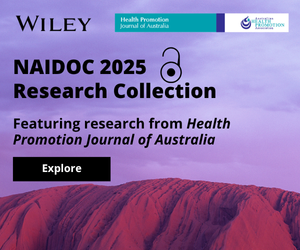Journal list menu
Export Citations
Download PDFs
Towards a more unified definition of health promotion
- Pages: 82-85
- First Published: 01 August 2003
A clear definition is essential for providing guidance to the scope and nature of health promotion for health promotion practitioners, researchers and their clients. The definition can facilitate planning, implementing and evaluating interventions. In addition, the credibility of health promotion as a professional entity will benefit from a definition that describes uniformity of action.
Budget auditing: a process to assist planning for health promotion services
- Pages: 86-89
- First Published: 01 August 2003
The budget audit contributed to a better understanding of how resources are used. It helped develop a shared vision and commitment to change by involving staff in making decisions about budget allocation. It is a useful tool for planning and resource allocation for health promotion services.
Promoting smoking cessation among pregnant women: routine antenatal care guidelines
- Pages: 90-94
- First Published: 01 August 2003
If smoking cessation guidelines for antenatal care are adopted and disseminated broadly, the potential for preventing tobacco-caused perinatal morbidity and mortality could be substantial. This paper reports on a major advance that has been made in achieving this.
10,000 Steps Rockhampton: Establishing a multi-strategy physical activity promotion project in a community
- Pages: 95-100
- First Published: 01 August 2003
The project, which emphasises multi-level strategies and a balance between ‘top-down’, researcher-driven consultation and ‘bottom-up’ input from key contacts and organisations, took about eight months to develop. Researchers and funders should not underestimate the amount of time needed to develop whole-of-community interventions.
Health promotion and screening for cardiovascular risk factors in NSW: a community pharmacy model
- Pages: 101-107
- First Published: 01 August 2003
The positive experiences reported by consumers suggests that a community pharmacy offers increased access, especially in rural areas, and a broadening of consumer choice for health promotion and screening services.
Smoke near me and I smoke too': evaluation of a smoke-free homes program in central Sydney, NSW
- Pages: 108-113
- First Published: 01 August 2003
It is possible to increase respondents' recall of the campaign and knowledge of some harm reduction strategies, but a longer intervention is needed to change smoke-free home status.
Reforming Andy Capp? How a cartoon character was used in a community alcohol project
- Pages: 114-118
- First Published: 01 August 2003
Health promotion projects, particularly those being undertaken in small or remote communities, should view the cartoon strip or comic as a useful tool with which to present their message to the community. This is especially the case where there are distinct local issues that render State or national campaigns less relevant.
Ethnic community group leaders' views on passive smoking in their community
- Pages: 119-122
- First Published: 01 August 2003
Most studies of health message dissemination refer to the mainstream community. This study provides a guide as to how well the passive smoking message has reached ethnic communities. The findings of this study show that they have received the message, but more slowly. This suggests that information and education should be targeted to community groups who still may not have a good understanding of the passive smoking message.
Skin cancer risk behaviours among adolescents in a Sydney metropolitan school
- Pages: 123-127
- First Published: 01 August 2003
Adolescents reported infrequent use of sun-protective methods and high incidence of previous sunburn experience, indicating a cause for continued concern. Findings of gender differences in behaviours and preferences provide direction for targeting sun-protective risk behaviours among adolescents. Since preferences were reflected in behaviours, we suggest that efforts to change adolescents' attitudes should transfer to their actual sun-protective behaviours.
Lesbians' experiences of cervical screening
- Pages: 128-132
- First Published: 01 August 2003
Future cervical screening programs should involve health care providers and encourage open communication and positive interactions between them and their clients.
Evidence-based practice and health promotion
- Pages: 133-136
- First Published: 01 August 2003
Walking to school in inner Sydney
- Pages: 137-140
- First Published: 01 August 2003
Partnerships between schools, councils and the health sector that focus on encouraging walking to school can achieve small increases in physical activity and overall environmental improvements.
Fruits and vegies in lunchboxes – accuracy of a prospective 24-hour food record for primary school children
- Pages: 141-143
- First Published: 01 August 2003
The TFV food record is a useful and acceptable tool for monitoring children's fruit and vegetable intakes.
Using health promotion frameworks to effectively address health inequalities
- Page: 144
- First Published: 01 August 2003







